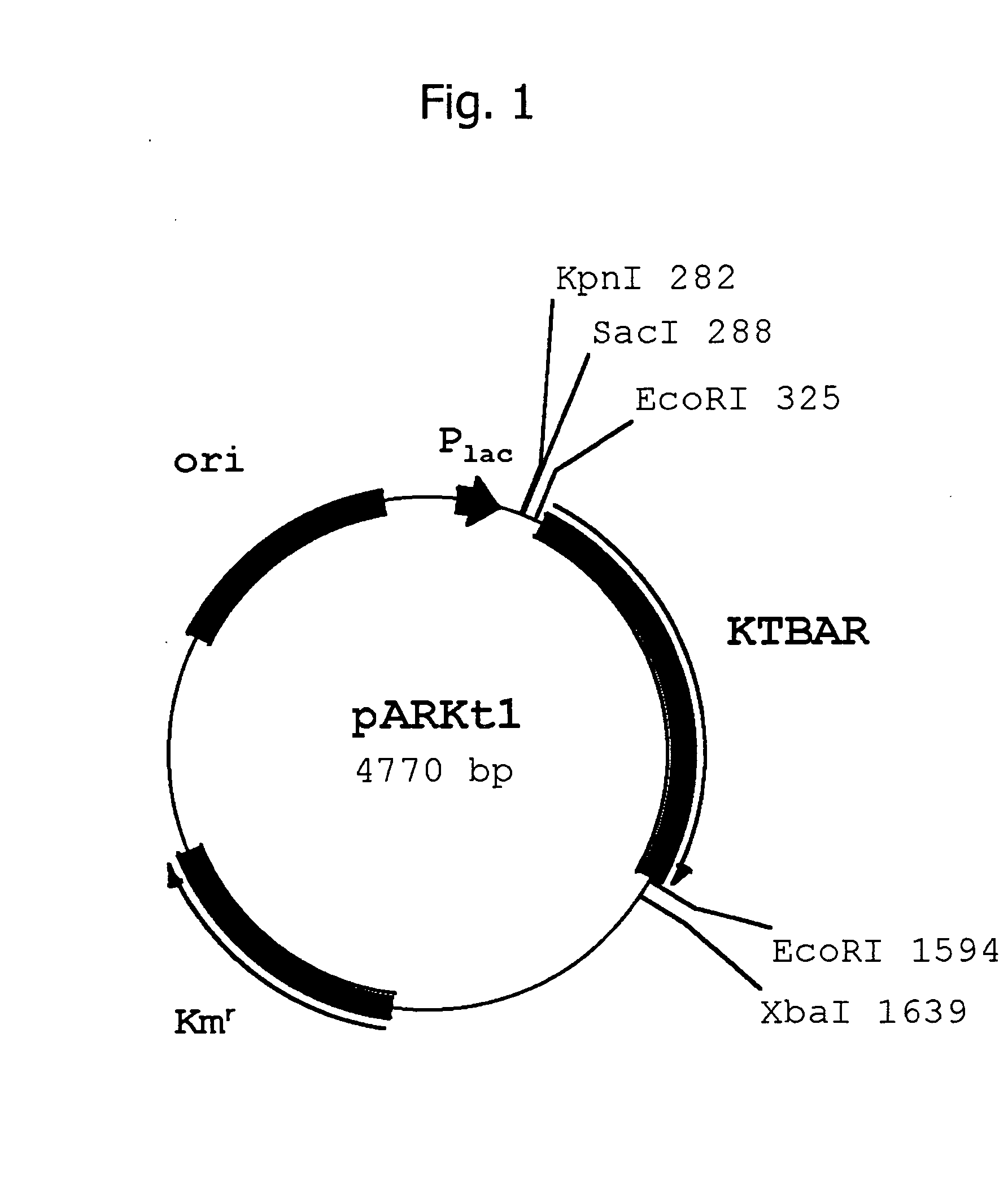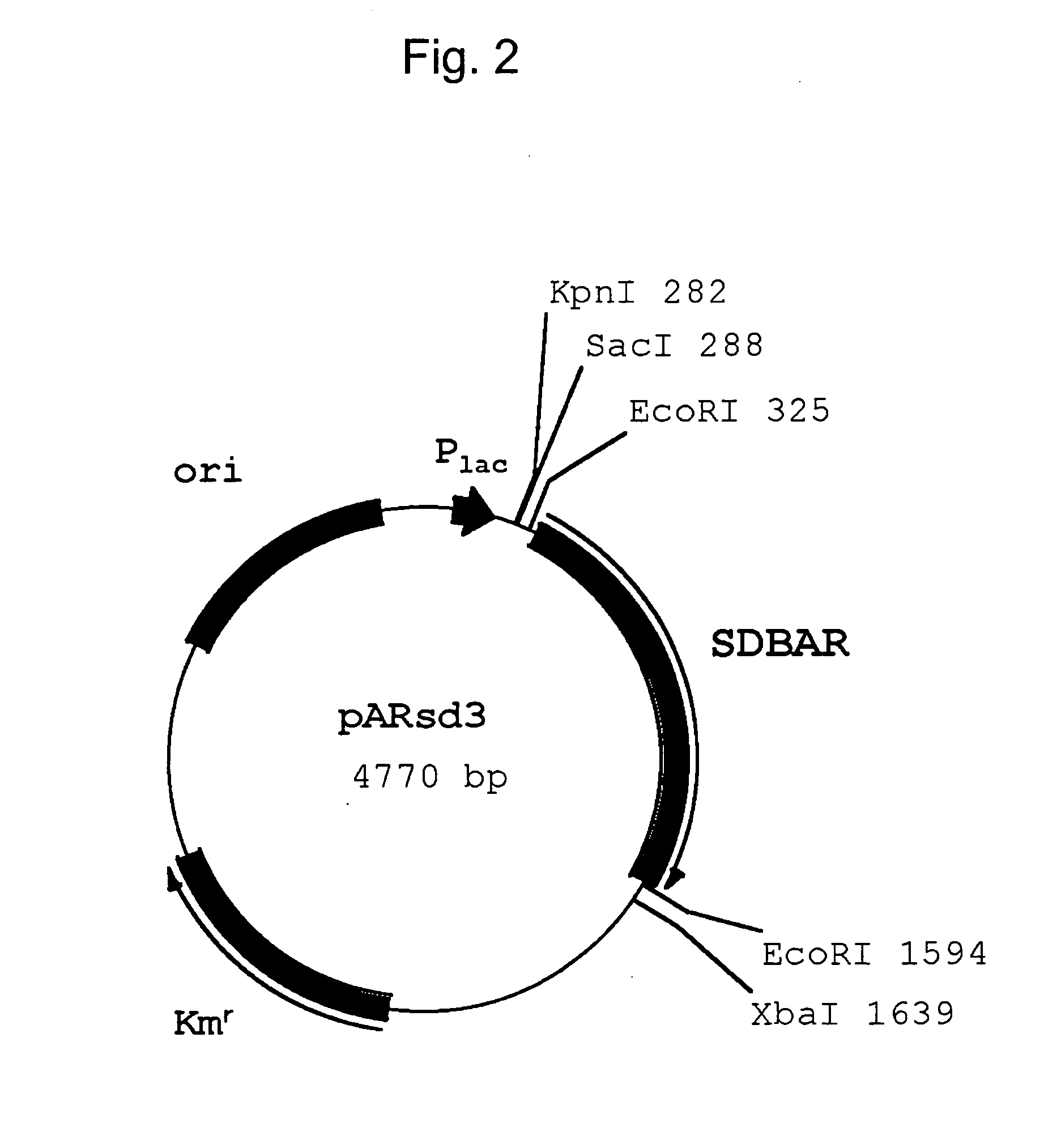Amino acid racemase having low substrate specificity and process for producing racemic amino acid
a technology substrate specificity, which is applied in the field of amino acid racemase having low substrate specificity and process for producing racemic amino acid, can solve the problems of difficult to fully compensate this defect, weak activity of the enzyme, and no report on the dna sequence encoding the enzyme or on a successful high-level expression
- Summary
- Abstract
- Description
- Claims
- Application Information
AI Technical Summary
Benefits of technology
Problems solved by technology
Method used
Image
Examples
example 1
Identification of a Low-Substrate-Specific Amino Acid Racemase Gene Utilizing Genomic DNA Nucleotide Sequence Database of Pseudomonas putida KT2440 (ATCC 47054)
[0152] A homology search was performed against the genomic DNA nucleotide sequence database of Pseudomonas putida KT2440 (ATCC 47054) [http: / / www.ncbi.nlm.nih.gov / Microb#blast / unfinishedgenome.html] using, as a query, the amino acid sequence shown in SEQ ID NO: 5, which is an internal amino acid sequence of low-substrate-specific amino acid racemase of Pseudomonas putida IF012296, and using program TBLASTN 2.1.1.
[0153] As the result, the DNA consisting of the nucleotide sequence shown in SEQ ID NO: 3 was identified as an open reading frame encoding a protein containing the amino acid sequence wherein 13 amino acids were identical to those of the 14-amino acid sequence shown in SEQ ID NO: 5.
example 2
Construction of a Transformant which Expresses the Low-Substrate-Specific Amino Acid Racemase Gene Derived from Pseudomonas putida KT2440 (ATCC 47054)
[0154]Pseudomonas putida KT2440 (ATTC 47054) was cultured using an ordinary bouillon medium (Kyokuto Pharmaceutical Industrial Co., Ltd.) at 30° C. for 24 hours, and the culture was centrifuged to obtain cells.
[0155] The chromosomal DNA of the microorganism was isolated and purified from the cells by the method described in Current Protocols in Molecular Biology.
[0156] On the basis of the nucleotide sequence assumed to be the low-substrate-specific amino acid racemase gene of Pseudomonas putida identified in Example 1, a set of primer DNAs having the nucleotide sequences shown in SEQ ID NOS: 6 and 7 were synthesized using a DNA synthesizer (Model 8905, PerSeptive Biosystems).
[0157] The DNA fragment assumed to be the low-substrate-specific amino acid racemase gene of Pseudomonas putida KT2440 (ATCC 47054) in Example 1 was amplified...
example 3
Construction of a Transformant Which Expresses the Low-Substrate-Specific Amino Acid Racemase Gene Derived from Pseudomonas putida IF012296
[0164]Pseudomonas putida IF012296 was cultured using an ordinary bouillon medium (Kyokuto Pharmaceutical Industrial Co., Ltd.) at 30° C. for 24 hours, and the culture was centrifuged to obtain cells.
[0165] The chromosomal DNA of the microorganism was isolated and purified from the cells by the method described in Current Protocols in Molecular Biology.
[0166] On the basis of the nucleotide sequence assumed to be the low-substrate-specific amino acid racemase gene of Pseudomonas putida KT2440 (ATCC 47054) specified in Example 1, a set of primer DNAs having the nucleotide sequences shown in SEQ ID NOS: 8 and 9 were synthesized using a DNA synthesizer (Model 8905, PerSeptive Biosystems).
[0167] A DNA fragment assumed to be the low-substrate-specific amino acid racemase gene was amplified from Pseudomonas putida IFO12296 which had been known to pr...
PUM
| Property | Measurement | Unit |
|---|---|---|
| temperature | aaaaa | aaaaa |
| pH | aaaaa | aaaaa |
| pH | aaaaa | aaaaa |
Abstract
Description
Claims
Application Information
 Login to View More
Login to View More - R&D
- Intellectual Property
- Life Sciences
- Materials
- Tech Scout
- Unparalleled Data Quality
- Higher Quality Content
- 60% Fewer Hallucinations
Browse by: Latest US Patents, China's latest patents, Technical Efficacy Thesaurus, Application Domain, Technology Topic, Popular Technical Reports.
© 2025 PatSnap. All rights reserved.Legal|Privacy policy|Modern Slavery Act Transparency Statement|Sitemap|About US| Contact US: help@patsnap.com


